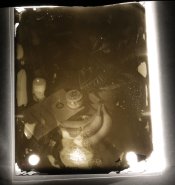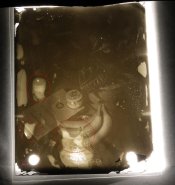EPIC Fail
Ok, last night was both good and bad. Good in that I successfully reversal processed 5 sheets of film, bad in that the 6th and unsuccessful sheet was my screen-plate positive.
I honestly can't say what went wrong. Basically it's as dense as a black hole and would take a nuclear explosion to project it; however, the image is in there, you just have to hold it up to a bare bulb to see it. Not to mention there are very funky looking swirlies, anomalies, etc., all undoubtedly due to the gelatin-binding.
It was on Delta 100, just like the previous one, and I shot it at ISO 12 (screen-plate figured in), whereas the previous one, as seen above, was shot at ISO 25 and sent to dr5 chrome (rating the film itself at 64)
One screen
is a bit denser, so I'll test that, but I don't think enough to account for this total failure, nor do I think that my reversal processing lost that much speed, since the other 5 sheets had a shot or two on DLTA 100 shot @ 75 and looking good.
So, there's got to be something going on with the gelatin binding that's destroying its sensitivity, or I'm underexposing, or both. At any rate, the anomalies present in the image and the labor required to bind the two sheets is worth abandoning this method for the time being.
I'll try to post an image at some point.
So, quite literally
back to the drawing board. PE suggested carboxy-methyl-cellulose to bind the sheets, of which a substitute is K-Y Jelly. So that's worth exploring, and if it doesn't work, hey, at least I've got some K-Y.

Other thoughts; how about a plate holder with some kind of pressure/spring-loaded glass to press the sheets together. This would be great if I could find such a unit, but I like the idea of being able to use pretty much basic film holders (albeit slightly modified) and elimating another substance that the light has to pass through. But, I'm not above it..
And what about static electricity? If I could somehow get these two sheets to have an affinity for one another, I'd be ready-set-done. As it is, without an adhesive or pressure, the sheets will invariably not making "pure" contact.
Lastly, S. Frizza's method was to introduce a slight bend in the films. Although I think it's a good idea, I don't know how I would achieve this in the holder, nor do I like the idea of bending the film plane. But Stephen, what kind of film holder did you use for the bend?
Thanks y'all... pour fourth your best ideas, help!








